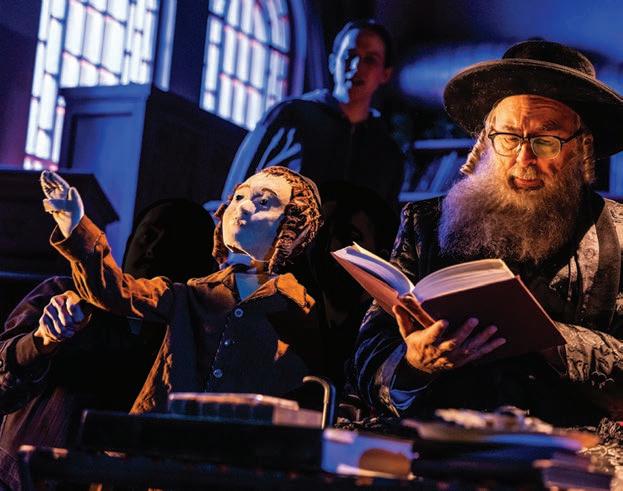Hop
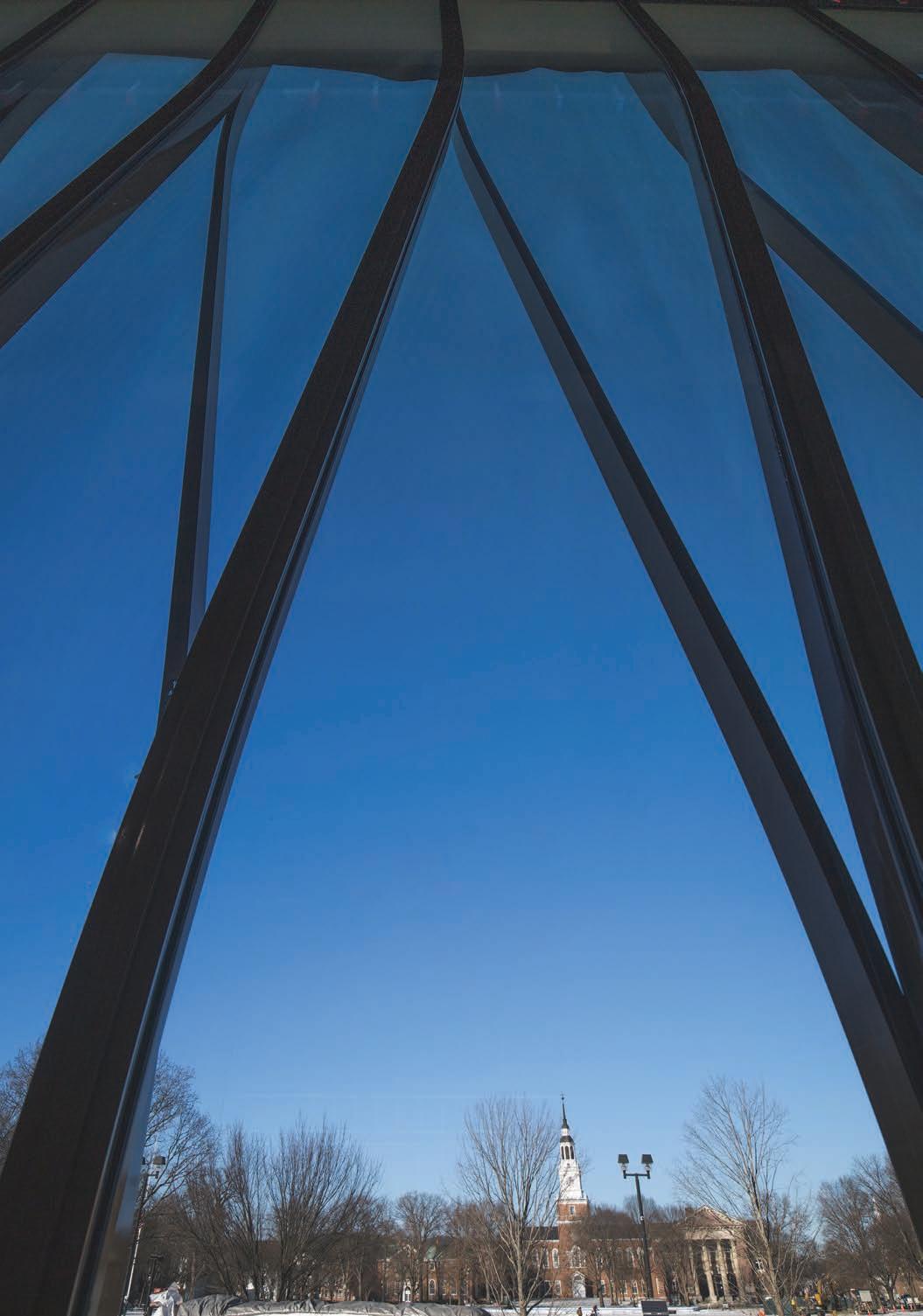
Spring/Summer 2025
Arts-powered research in action


Spring/Summer 2025
Arts-powered research in action
By Mary Lou Aleskie Howard Gilman ’44 Executive Director
When the world feels increasingly divided, the arts remind us of our shared humanity. Step into a performance, a workshop or a classroom where creativity is unfolding and you will witness the power of the arts first-hand: sparking conversation, shifting perspectives and fostering deeper connections. At the Hop, we recognize the arts as essential to how we learn, connect and make sense of the world.
Our foundation is built on the various programs and pillars that shape our artistic community here at Dartmouth—from the excellence of our student ensembles to the groundbreaking collaborations between faculty and artists across disciplines to the visionary work of our resident artists. These elements come together to cultivate a dynamic, ever-evolving arts ecosystem—one where innovation thrives, experimentation is embraced, and new possibilities emerge every day. That is why our integrative approach to the arts is a pillar of our work at the Hop; because we believe in the
boundless potential that arises when art and ideas converge. This ecosystem is enriched by our commitment to freedom of expression, ensuring that everyone is welcomed and empowered to engage in a way that feels authentic to them.
From this strong foundation, our reach extends far beyond our walls and engages with broader global conversations. Hop-commissioned works tour internationally, expanding the impact of the seeds that are planted here. Our student ambassadors perform, collaborate and exchange ideas with peers across the globe, bringing their artistry into new contexts. Our interdisciplinary projects transcend geographical and academic boundaries, proving that the arts are not only a means of self-expression but also a powerful force for change. Alumni carry this creative spirit into their careers and communities, generously sharing their time and talent—and we are the grateful beneficiaries.
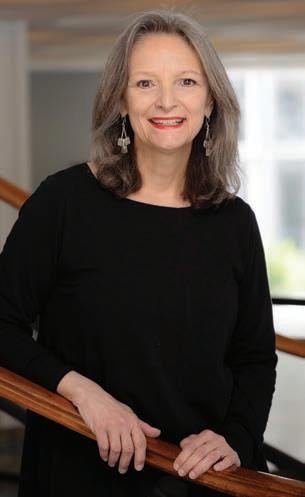
As we prepare to reopen our iconic building, we’re excited to welcome the community into expanded, more accessible spaces designed for gathering, creating and experiencing the arts. With new venues for experimentation, informal performance and connection, the Hop will deepen its impact and foster even greater creativity on campus and beyond.
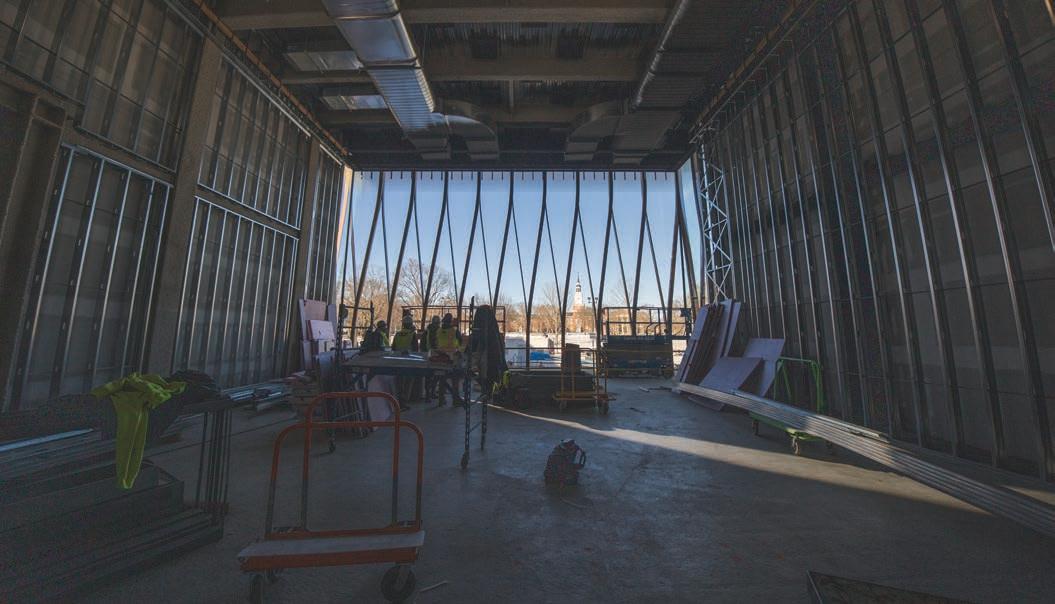
By Asmaa Abdallah Communications Manager
Reading blueprints, understanding materials and mastering structural engineering are all essential to architecture. But designing an acoustically optimal arts center requires the sensibility of an artist. Joe Solway, the Acoustic Consultant on the Hop Project and a saxophonist/trumpet player, puts it this way: “You have to have the creative, music side as well as the engineering and construction side, and have the two meet in the middle.”
Acoustics in a performing arts center involves three elements: room acoustics, sound isolation and the building system. Snøhetta and ARUP, the design consultancy for the project, are working to optimize all these factors, so that we can realize our full programmatic vision building. This included determining the ideal volume and geometry of
each space, selecting specific material finishes, and controlling sound from heating, ventilation and plumbing.
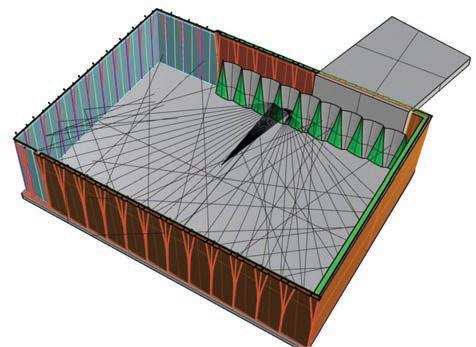
Adaptability defines both the spaces and their acoustics.
The recital hall, for instance, is designed primarily for solo and small ensemble performances but features a movable curtain system and banners that allow for tuning the room. For chamber music or choir, a more reverberant environment enhances the natural warmth of the sound, while for jazz, pop, or amplified music, the curtains and banners reduce the reverberation, creating a drier sound. Similarly, the performance lab was designed to accommodate a wide range of sound sources, from amplified and unamplified music to drama and speech. Like the recital hall, it features a curtain system for sound absorption and
ARUP and Snøhetta conducted a ray-trace study of the recital hall’s wall shaping to achieve the right balance of sound diffusion. Courtesy of Arup
wood patterns on the walls that scatter sound and enhance speech clarity. Hartman Rehearsal Room has also been enhanced for greater adaptability. Larger, louder ensembles now benefit from a movable curtain on the back wall, allowing for more sound absorption when needed. The beloved Spaulding Auditorium also received an upgrade to improve its adaptability. Originally designed for unamplified music such as orchestral performances, it lacked adjustable acoustics for amplified concerts. A drop-down banner
system on the side walls, similar to the recital hall, reduces reverberation for amplified music and speech, improving clarity.
“Performances such as the Coast Jazz Orchestra or any band that has microphones, drum kits or a guitar amp will sound better because the music is not bouncing around the room uncontrollably,” says Todd Campbell, Production Manager at the Hop.
To accommodate multiple performances and rehearsals simultaneously, sound isolation was a key focus. The goal was to control sound while allowing just enough bleed to let visitors sense the building’s energy and feel drawn inside. A thick concrete slab between the recital hall and the dance studio, for instance, ensures that rehearsals or performances in one space do not disturb the other. Since dancers rely on clear, precise beats, the dance studio was designed to be relatively dry, especially with amplified music. To achieve this, sound-absorbing ceiling and wall finishes were incorporated.
The recital hall’s ceiling-length glass wall, which offers stunning views of the Dartmouth Green and Baker-Berry Library, also posed an acoustic challenge. “One of the studies we did was to measure the different sound levels as the buses stop, idle and roar off,” says Solway. This data helped determine how thick the glass needed to be to prevent exterior noise from infiltrating performances. The iconic Top of the Hop, with its big arches, glass walls and hard floors, also underwent some adjustments to reduce noise infiltration.
A key consideration here was to modernize the acoustics while preserving the character of the original Hop. Removing the central staircase eliminated a major source of noise, while sound-absorbing materials were subtly integrated into the arches without impacting the shape and feel of the space.
Closely connected to the acoustical design is the new, user-friendly audio system, which allows performances to be easily broadcast or transmitted to another space within or outside the building. “In some cases, you can
grab a microphone and be able to use the room without any kind of setup or teardown, says Campbell. “Not only will it sound better, it’ll also save time.”
As the opening approaches, excitement is building among artists, faculty and the community. Hop pianist-inresidence Sally Pinkas, who will perform in the recital hall, captures this anticipation. “I will have much more direct contact with the audience: I will be able to see them, whereas in Spaulding, they were a distant mass. What I love about performance is the communication, and here it will be palpable.” That spirit of connection is at the heart of what we love about the arts—and we can’t wait to experience it in the new Hop with an exceptional acoustic experience.
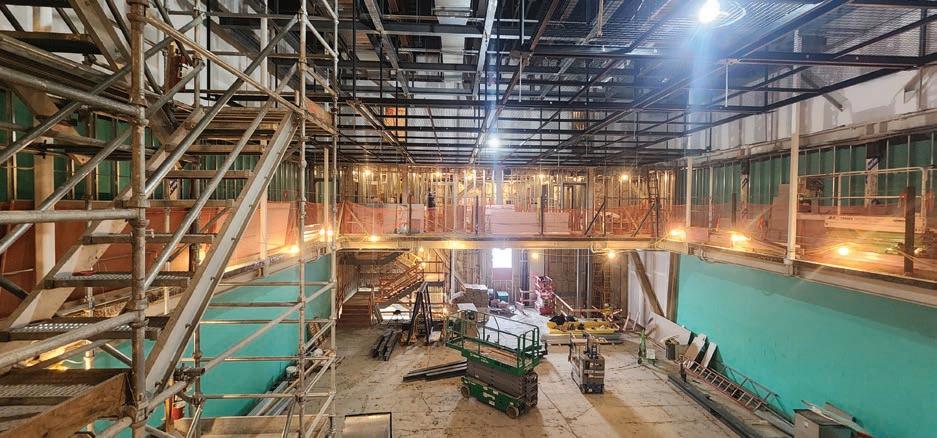
By Asmaa Abdallah
It started with two yoga mats, aluminum foil, duct tape and alligator clips. Several iterations later, Rebecca Abraham’GR and Albert Zhang GR now have a full-fledged Magical Musical Mat: an interactive instrument that plays music by sensing physical touch. Players activate sound by standing on mats embedded with conductive sensors and touching each other.
“The technology behind it is really simple,” says Rebecca. “That’s what makes it magical.”
“The idea was first born when Rebecca was an undergraduate student at UC Berkeley, working on a research project with Dr. Rachel Chen and Arianna Ninh that developed the Magical Musical Mat as a communication tool for autistic, non-speaking children. Now, studying Sonic Practice at Dartmouth, Rebecca has put their electrical engineering and computer science degree to work in creating a touchbased instrument. Partnering with
Albert, a visual artist and fellow Sonic Practice graduate student with a passion for dance, brought in the choreographic element of the project.
It was a big learning experience. “The most exciting challenge of this project was expanding a communication tool into an artistic instrument,” says Albert. “How do we translate physical touch into sound? How do we make the sound dynamic? We answered these questions through play and improv with the instrument and allowing everyone’s respective talents to shine.”
For Rebecca, too, the project became an entry point into a new creative process. Despite their background in classical piano, Rebecca’s foray into music composition came by way of… dance. “I saw myself as a technical person, an engineer. Composing to me meant putting notes down on scores which felt intimidating. Then I realized there are other ways to
compose that are more intuitive as well as expansive and generative.”
The first version of the mat has undergone many changes—both the mat itself and the supporting hardware and software have been replaced to improve durability and adaptability to different environments. Rebecca and Albert, supported by a community of DIYers and Dartmouth faculty members, experimented with different types of conductive fabrics.
Funding from the Arts Integration grant enabled them to further their experimentation and bring the mat into the world, sharing it with artists, scholars and audiences in different contexts. Around 20% of the grant supported their first residency in Thetford, Vermont, where they invited dancers Laura Coe and Rafael Candela to explore the mats. It also helped fund the short film, A Thousand Mornings, using footage captured from that weekend.
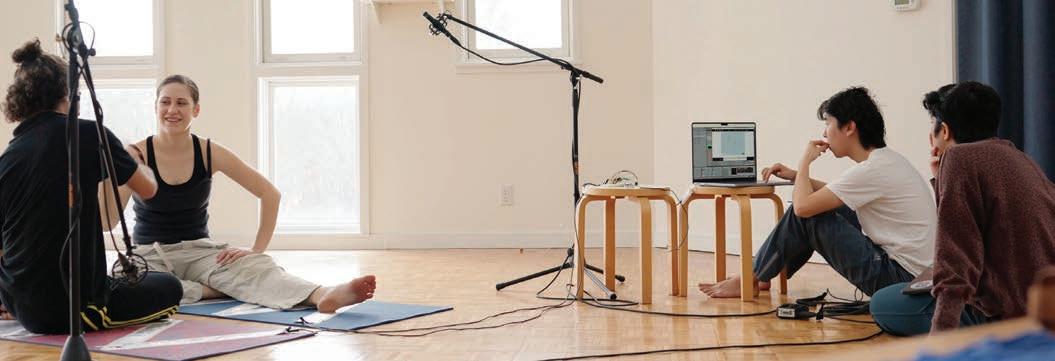
Over the summer, the Magical Musical Mat was workshopped during a week-long residency in upstate New York with dancers Laura Coe and Alan Kuang, where they performed at a farmers market and a community library. Later, they brought it to Jacob’s Pillow as part of their Community Day. Eventually, the mat landed in Utrecht, Netherlands, at the leading research conference Novel Interfaces for Musical Expression, where they performed at the opening concert and won the Best Music Installation award.
Looking ahead, Rebecca and Albert hope to take the project on a more expansive tour, including a performance and interactive workshops at the Hirshhorn Museum in DC this spring, as well as further develop the 10-minute dance into a three-act piece. But beyond performances, they see the mat as a tool for connection— one that invites audiences to engage with music, movement and touch in a completely new way.
The Arts Integration Initiative organizes regular networking events and information sessions to connect faculty, students and researchers interested in leveraging the arts in their work
< Rebecca Abraham and Albert Zhang collaborate with dancers Laura Coe and Rafael Candela during a residency in Thetford, Vermont.
Photo by Daniel Huang
Cyber Folksongs for Digital Nomads: A Sound Ethnography
Hermia Miaoxuan Huang ’26
Bronzed: A History of Makeup, Hair and Race in Hollywood
Desiree Garcia
associate professor and chair, Department of Latin American, Latino, & Caribbean Studies
Medical Misogynoir: Graphic Medicine as a Tool to Raise Awareness of Medical Misogynoir Across Three Centuries in the US
Shontay Delalue
senior vice president and senior diversity officer
Vinald Francis
biomedical illustrator and graphic medicine artist, Geisel School of Medicine
Vicarious: An Interactive Hologram Stardom Experience
Luke Cargill ’24, Guarini ’26 master of science in computer science with concentration in digital arts
Visualizing Vermont Flooding: Mapping the White River with Drone Media
Hayden Miller ’25
DROP: An Immersive Journey through Water
Malik Terrab ’25
Peyton Bond ’24 intern, Department of Studio Art
Living Interpretations: A Digital Exploration of Ambiguity in Art
Clara Sava-Segal Guarini ’24 PhD in cognitive neuroscience
Emily Finn assistant professor, Department of Psychological and Brain Sciences
Georgia Nieh ’27
Neely McNulty curator of education, Hood Museum of Art
Art, Business, and Soft Power
Chad Elias associate professor, Department of Art History
Sunglim Kim, associate professor, Department of Art History and the Department of Asian Societies, Cultures, and Languages
Under the Moving Skin: E-textile Wearables for the Performing Arts
Ivy Fu Guarini ’25
Quilting for Resilience:
Stitching Together Stories of Mutual Aid from Vermont’s Floods
Sarah Kelly research scientist in the Energy Justice Clinic at the Irving Institute for Energy and Society and a lecturer in the Department of Geography
Aletha Spang GIS specialist, Department of Geography
Charis Boke lecturer, Department of Anthropology
By Vivian Wang ’27 2024/25 Hop Fellow
While many students took advantage of this past winterim to spend time away from their academic pursuits, Loane Bouguennec ’25 and Emma Ratchford ’25 used the time to immerse themselves in ethnographic research. Over three-and-a-half weeks in Brazil, the duo explored the intersection of commercialization, culture and community through the lens of samba.
The project “Samba & Communitas: Reflections on First Time Ethnographic Field Work” focused on studying the role of commercialization, and specifically tourism, within the Brazilian art form.
The term “communitas,” which describes the community that results from rituals, comes from the chapter “Liminality and Communitas” in The Ritual Process by Victor Turner. Bouguennec and Ratchford studied Turner’s theories in an ethnography course as part of their preparation for the research.
“Samba is something that people will come to Brazil to see,” says Ratchford, a Government and Environmental Studies double major and Music minor. “We wanted to understand how, if at all, the presence of these outsiders changes samba, which is something that’s so quintessentially Brazilian.”
In addition, their research explored how the context, history and community of samba are embedded
in its current practices and communicated to outsiders.
The idea for the project came about last summer when Bouguennec, a Philosophy major with minors in Human-Centered Design and Creative Writing, became interested in participatory music, particularly how the genre blurs the line between performer and viewer.
As the pair began researching samba, they became drawn to the tension between samba’s traditional roots and its public consumption, a perspective they realized was heightened by their own position as outsiders. “Looking at an angle that we had more access to allowed us to look at it with more depth,” Bouguennec explains.
In Brazil, Bouguennec and Ratchford attended performances and rehearsals, interviewed musicians and audiences, and spoke with a professional samba dancer named Katarina Harmony. Their fieldwork spanned two locations—Rio and Salvador—allowing them to explore contrasting samba styles. Rio’s dominant school-based style offered a sharp contrast to the more
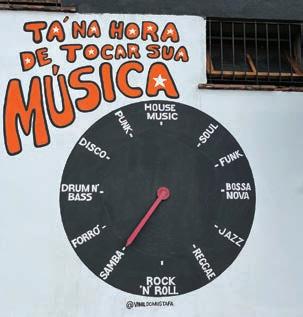
community-driven approach in Salvador.
The duo received funding from the Hop, in addition to grants from the Leslie Center and the Department of Music. The funding allowed them to access various performances and visit the two cities.
Although the trip was less than a month, the relationships the pair cultivated left a lasting impression.
“People welcomed us with so much openness and excitement to talk to us about their lives and their relationship to samba,” Bouguennec reflects. “They brought us into their social worlds and gave me a new perspective about my life. I came back to Dartmouth with fresh eyes and just more joy.”
Although she is not pursuing an arts major, the research experience has encouraged Ratchford to pursue more arts-related work in the future.
“I always forget how important it is to me, and then I do a project like this and I just get so excited again about continuing to pursue artistic fieldwork,” she says.
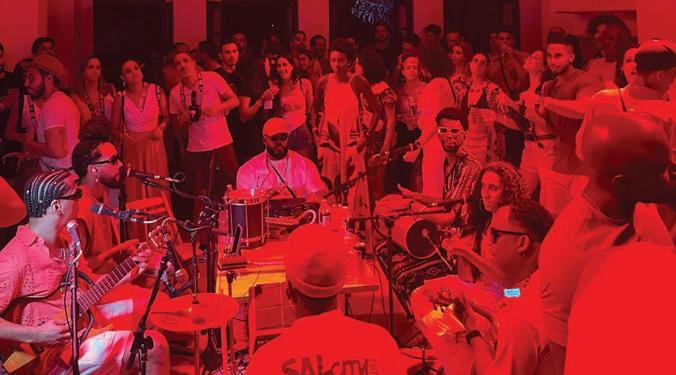
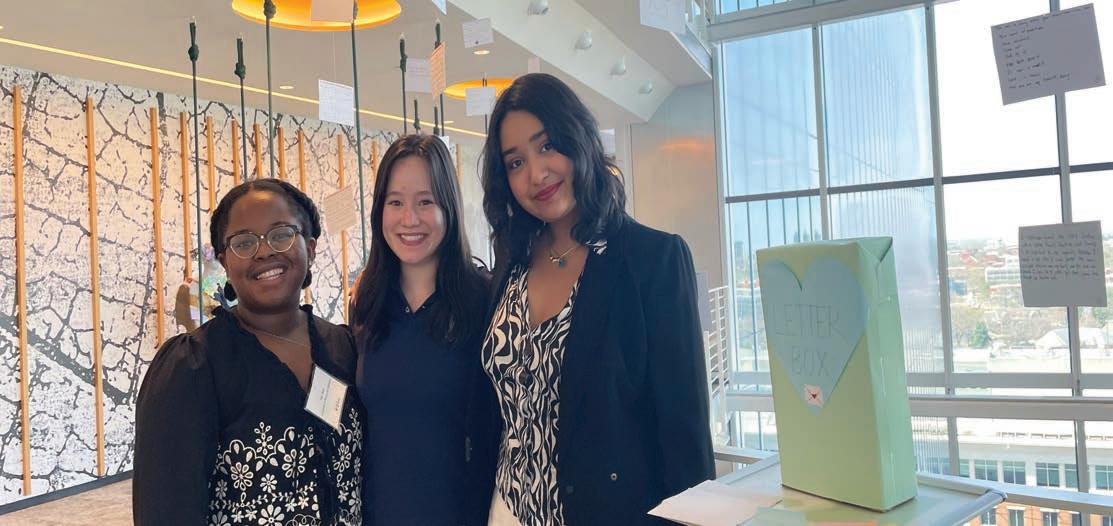
This year’s Alliance for the Arts in Research Universities (a2ru) Creatives Conference was hosted by Atlanta Technical College in Georgia. Together with students from various disciplines, we explored the summit’s theme: Resonate.
On day one, we met at Coda: Georgia Tech’s state-of-the-art design center where we formed teams based on which facets of “Resonate” interested us most. Lauren ended up in “Resonating in the body” while Ivie and Emma joined the “Bang!” team. Lauren’s group (Team Seahorse) explored how emotion is embodied, with a focus on personal stories of love. Ivie and Emma’s group (Team Bang2) examined the idea of an initial small entity that grows gradually, inspired by water ripples. Their project aimed to create a series of moving images with growing shapes to reflect themes of sustainability vs. urbanization, capitalism and gentrification. It was exciting to apply everything we’ve learned about teamwork and collaboration working as Hop Fellows in our individual working groups at this summit.
The next day each team finalized their project. For Lauren, this included collecting, digitizing, and analyzing handwritten postcards prompting other attendees to share an experience with love. For Ivie and Emma, this concluded in an adventurous field trip around Atlanta to document the city’s natural habitats and contrasting urban infrastructure.
On the final day, after some lastminute adjustments, we began our presentations. Team Seahorse presented a digitized webspace and color-coded installation of the postcards they had distributed the previous day. Team Bang2 shared an abstract compilation of images representing the natural and manmade landscapes of Atlanta set to Outkast’s “Gasoline Dreams” indicating a critique of capitalism and unsustainable practices. The other projects were incredible, too; from technical, sound-based water resonations to adult mindfulness—playgrounds, the work that everyone had accomplished in three days was inspiring.
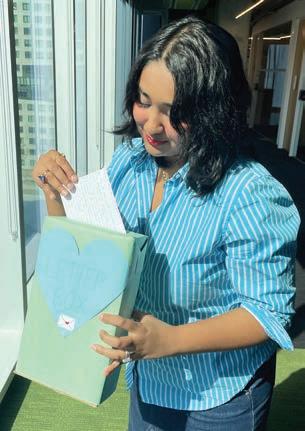
With new connections made and social media accounts followed, we left the conference as alumni of a2ru—grateful for the time we spent in Atlanta and the community of emerging creatives we had developed along the way. It was genuinely such an amazing opportunity to experience real-world collaboration with other youth creatives outside of an academic context and we will definitely carry everything we learned with us in our future creative endeavors.
By Michael Bodel Director of External Affairs
There’s a lot going on in this show—a lot going on in one body. Despite being a solo work, Vegan Chitlins (or the Artist Formerly Known as the N-word) by dance artist Trebien Pollard bursts with recollections and gestures tracing the ever shifting experience of being—and being seen as— Black. Recorded and spoken text meld with looping gestures and finelytuned facial expressions. For fleeting moments, we encounter the lone performer’s many selves. Or maybe the many people housed within his single self?
At one moment, Pollard steps off stage into an intimate beam side light, and there is a frenzy of various characters coursing through his choreography. We are jolted between a casual Queer man joking with his friends, a rapper, an erudite scholar, a caricature of Blackness wrenched from antebellum minstrelsy that clearly—as the title of his work indicates—Pollard still feels projected on him today. He dons a multilayered black dress, and later in the work, he spins. In his whirling, we see his “worlding” as he sheds the layers of this Gothic gown, revealing other layers… other Black selves.

Pollard sees this as a sort of shapeshifting, and the quick and unstable switching between these personas becomes a choreography. It is a dance of a distributed person.
Speaking with the Hop Resident Artist, he describes how he has moved through white and Black spaces throughout his life. And that Blackness feels so different in these different contexts—growing up throughout the South, performing in companies from Martha Graham to Ronald K. Brown, teaching in universities from rural New England to larger state schools. He has always felt like the same person, but is swayed by the power of outside perception—of others seeing him as Black and even Black-first. In each environment, Pollard has transmuted his way of being and moving, even his
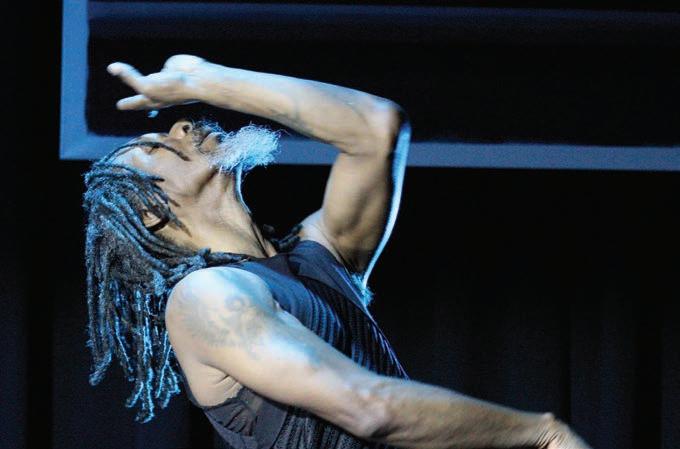
by Julie Lemberger

personality. A central question that he moves through so forcefully in this work is “what happens when an identity is so constantly influx of being made and unmade? Where is the underlying core of the self?
Critic Nicolas Bourriaud describes art as “a state of encounter”, and in Pollard’s work, we encounter a body quaking with the burden and the beauty of his many Black selves. We are rapt by the virtuosic performance of quick-switching, we are jostled by him, and moved by him. And in one exceptional and prolonged moment —a 2-minute section of stillness and direct gaze that Pollard experimented with during his Hop residency—we are forced to sit with him. As Pollard wonders “When do you ever really look at a Black person, like really see them… not just in passing? What does it mean to be close?”
Trebien Pollard is a New York-City based choreographer and dance artist who has been a member of Ronald K. Brown/Evidence, Bebe Miller Company, Urban Bush Women and Pilobolus. He regularly choreographs for the Dartmouth Dance Ensemble and performed in the Hop Original production of The Ritual of Breath Is the Rite to Resist.

By Theodore Levin
Arthur R. Virgin Professor of Music
What are the chances that watching a four-minute YouTube video featuring folksingers from Sardinia—the Mediterranean island best known for glitzy resorts— would transform the lives of four American aficionados of world choral traditions? That they would then master the art of Sardinian “throat-singing” and make a video that would go viral in Sardinia, turning them into local celebrities?
However unlikely the odds, that’s what happened to Tenores de Aterue (Singers from Elsewhere), the Vermont and New York-based vocal quartet in residence at Dartmouth this spring, working with students in world music classes and performing a Hop concert. During the residency, the Tenores will lead group singing sessions with the aim of offering students a taste of community music-making—a vital source of social bonding across much of the world.
“We all spent many years singing different kinds of traditional music,” said Tenores member Carl Linich, an accomplished singer and teacher known for his mastery of vocal polyphony from the Republic of Georgia. Linich and fellow Tenores
Avery Book, Gideon Crevoshay and Doug Paisley initially connected through their mutual interest in Georgian music. But after learning a Sardinian folksong in the fourpart style known as cantu a tenore, in which the bass sings in a raspy, guttural timbre that resembles Tuvan and Mongolian throatsinging, Linich became interested in the tradition and persuaded Book, Crevoshay and Paisley to explore it further.
Despite the recognition afforded by UNESCO’s inscription of cantu a tenore in its prestigious Representative List of the Intangible Cultural Heritage of Humanity, resources for nonSardinians who wanted to learn cantu a tenore were all but nonexistent. A YouTube search led Linich to a video in which a quartet of village singers offered a demo— in Italian—on how to perform their individual parts and as a single harmonized sound. “The demo was like our Rosetta Stone,” Linich recalled.
After three years of rehearsing, Tenores de Aterue gave their first public performance, in 2011, and videoed it. By then, they’d

established direct contact with singers in Sardinia, and Linich shared a link to the Tenores’ concert video. It quickly went viral. That a group of Americans had learned to sing—expertly— the challenging cantu a tenore repertoire nourished Sardinians’ pride in their unique culture and indigenous language, which UNESCO classifies as “definitely endangered,” its use in decline as younger people switch to Italian.
In 2013, the Tenores de Aterue made their first visit to Sardinia, where they were welcomed as cultural heroes. “When Sardinians see people from across the ocean showing a real interest in their culture by singing their songs, it pushes a different button for them. What they may have thought of as just a tradition from their village takes on a larger meaning.”
In their concert, along with music from Sardinia, Tenores de Aterue performed a cappella songs from Corsica, which is geographically and culturally close to Sardinia, and from the Republic of Georgia, the long-ago starting point of the group’s musical collaboration.
By Johanna Evans ’10 Senior Program Manager/ Head of Film & Media
Art has long been a catalyst for social change, and film is one of its most powerful tools. Whether through documentaries that weave facts with personal stories or fictional stories that imagine troubling futures, film has the ability to deepen understanding and inspire action. Recently, two Hop film collaborations provided students, scholars and activists with a meaningful space to convene, sharing their expertise and perspectives on some of today’s pressing issues.
This winter, we screened Zurawski v Texas, a documentary about the impact of Texas’s dangerously vague anti-abortion laws that premiered at the Telluride Film Festival to great acclaim, but is yet to find a distributor. Amanda Zurawski,
the lead plaintiff in the case, as well as filmmaker Abbie Perrault, participated in a robust campus residency that included a class visit, lunch with students and a post-film Q&A. This residency came together with support from a campus-wide coalition, including the Rockefeller Center for Public Policy, the Center for Social Impact, the Department of Women & Gender Studies, the Office of Pluralism and Leadership, and the Geisel School of Medicine. From OB-GYN students to a class on women in journalism, the audience spanned a range of perspectives on the risks to reproductive freedom.
Sometimes the goal in playing a film is to change hearts and minds, but it can be just as valuable to use film to bring together those who
are equally invested in a cause but have different knowledge to share. Films like Zurawski v Texas do preach to the choir, but everyone in the “choir” at the Loew on January 23 came away with new knowledge and new motivation.
Film is excellent for sparking conversations about where we have been and where we are now, but it can also prompt exploration for where we might go from here. This winter, the Hop Film team collaborated with the Department of Latin American, Latino & Caribbean Studies to present a conference on speculative fiction inspired by Alfonso Cuarón’s 2006 film Children of Men.
This conference, entitled “Children of Cuarón: Speculative Futures Through Cinematic Fiction,” is part
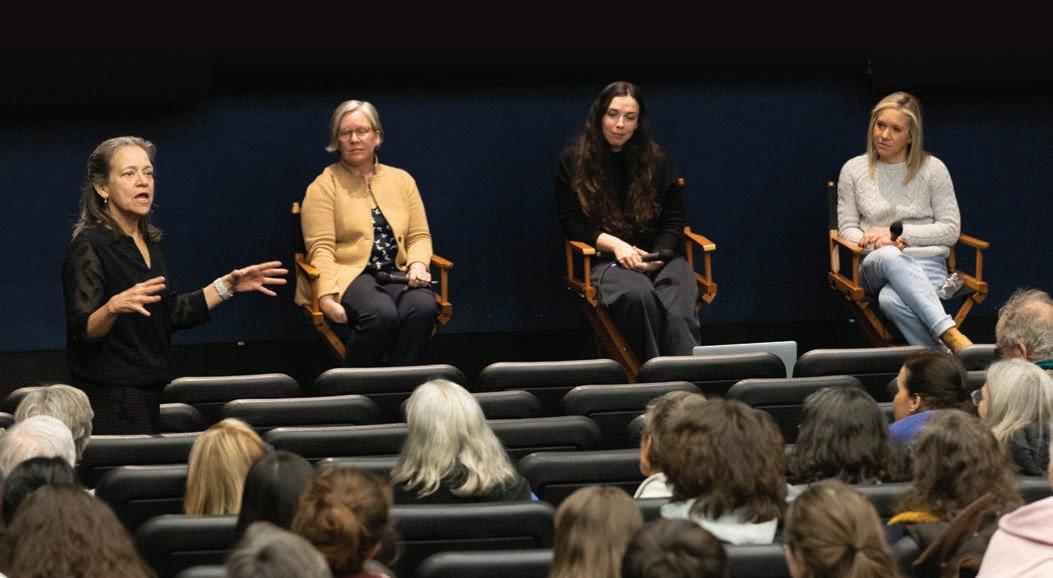
By Asmaa Abdallah
When Jim Nicola became Artistic Director of New York Theatre Workshop (NYTW), he quickly realized that while New York was an incredible place to create, artists needed to step outside the city to hear their own voices. They needed time and space to reflect on their craft, deepen relationships with collaborators and build community. This realization led to the birth of an enduring partnership between NYTW and Dartmouth College, a relationship that began in 1991 and has flourished ever since. Nicola’s predecessor and Dartmouth alum Jean Passanante ’75 helped lay the foundation by facilitating the initial connection between NYTW and Dartmouth. Over the last 33 years, the annual summer residency has evolved into a vital space for artistic exploration and community building.
For three weeks every August, the NYTW team and their artistsin-residence arrive at Dartmouth’s idyllic campus to engage in a rich mix of activities: class visits, workshopping new plays, rehearsals, communal dinners and
informal gatherings that encourage collaboration and cross-pollination of ideas. “Our time at Dartmouth is for process work,” says Aaron Malkin. “It’s not necessarily about making a play. It’s about processing the world that we’re living in, making space for new ideas, new ways of thinking, and new ways of being.” This emphasis on process over product creates a dynamic atmosphere where multiple groups of artists work simultaneously, fostering an environment where diverse voices and perspectives intersect.
“There’s something about being immersed in this place that allows artists to pause, reflect and connect in ways that are impossible in the bustle of the city,” says Mary Lou Aleskie, Howard Gilman ’44 Executive Director of the Hop. “The environment here nurtures a kind of creative openness that enriches both the artistic process and the community that forms around it.”
Over the years, the residency has hosted many artists and birthed
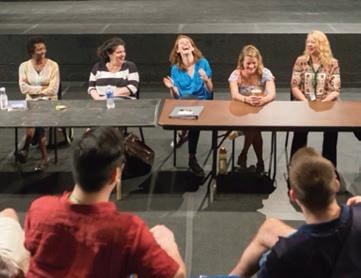
over 75 projects that have gone on to have remarkable lives beyond Dartmouth. Participants have included Denis O’Hare, Sharon Washington, Doug Wright, Dael Orlandersmith, Anaïs Mitchell, Kristina Wong, Ed Sylvanus Iskandar, Rachel Chavkin, Jeremy O. Harris, Martyna Majok and Ayad Akhtar. Rent, Hadestown, Kristina Wong: Sweatshop Overlord, The Laramie Project, Quills and An Iliad are just a few of the iconic works that have had remarkable lives beyond Dartmouth.
The NYTW residents engage deeply with Dartmouth students. Through the course “Summer Theater Lab,” students rigorously observe the rehearsal process, participate in seminars and even share their own work. “Dartmouth students bring their incredible intelligence and curiosity to the artistic process,” notes Malkin. And it has been equally meaningful for the students to get to engage with professional artists. The residency also fosters collaborations with Dartmouth faculty, such as talks that add layers of context to the pieces being developed.
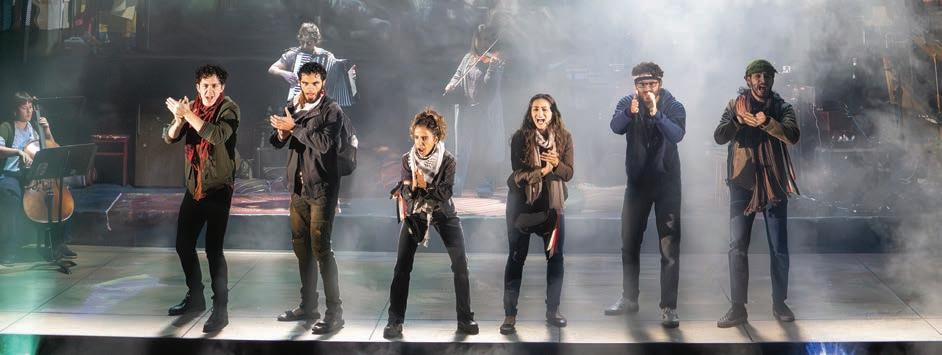
As NYTW transitions under the leadership of new Artistic Director Patricia McGregor, the partnership with Dartmouth is expanding. “Having developed some of our signature works at Dartmouth, our singular partnership will nourish the next generation of artists and storytellers from early explorations to full productions,” says Gregor.
Last fall, We Live in Cairo, a powerful musical about the Egyptian revolution workshopped at Dartmouth in 2018 served as a prototype of a broader vision for the partnership—using art as a nexus for community and conversation. NYTW and the Hop with support from the Tahrir Institute for Middle East Policy organized a series of events that centers the community represented on stage with the goal of rippling outwards.
The events involved Professor of Middle Eastern Studies Ezzedine Fishere, whose expertise deeply enriched the creative process. A former Egyptian diplomat, novelist and scholar who was an active force in the 2011 revolution, Fishere had already been collaborating with the playwrights during their Dartmouth residency, offering insight that reflects both historical accuracy and contemporary relevance. He continued consulting
with the theater company and participated in post-show discussions exploring the Egyptian revolution and its universal themes. “As a novelist and an academic, I always thought both roles informed each other,” Fishere said. “We Live in Cairo does exactly that. What students get out of attending rehearsals or watching a show is a lot more than what you can explain in a classroom.
Dartmouth also hosted the development of a second work featured in the NYTW season Becoming Eve, which was workshopped on campus in 2023. Following a performance, Dartmouth Professor of Religion Rachel Feldman was in conversation with Rabbi Abby Chava Stein whose memoir is the basis of the work. Together they discussed the themes of Eve, which tells the story of the child of a prominent Hasidic family whose identity as a trans woman comes into opposition with the strictly gendered world in which she was raised. Feldman, whose class on gender and Judaism explores similar questions, asked whether traditions can also be sources of creative inspiration and liberation—even if they have also caused harm. “The play is a
testament to the life-giving potential of sacred sources and the resilient, healing power of Hasidic joy,” she said. “I am proud of Dartmouth for supporting one of the most transformative works of Jewish theater I have ever seen.”
By bringing plays that unpack timely social issues and complex topics in a way that only art can, NYTW encourages artistic bravery—inviting both creators and audiences to engage with challenging themes. This aligns with the Hop and Dartmouth’s commitment to facilitating conversations that bridge political and personal divides says Aleskie, noting that both NYTW and the Hop are dedicated to pushing boundaries. “We believe in creating space for stories that stir thought and reflection,” she adds.
As NYTW and the Hop continue this journey, the possibilities for expanding community engagement and continuing to explore the intersection of scholarship and artistry are boundless. “We’re not just making theater,” says Aleskie. “We’re building community, deepening inquiry, and expanding the boundaries of what live performance can be.”
